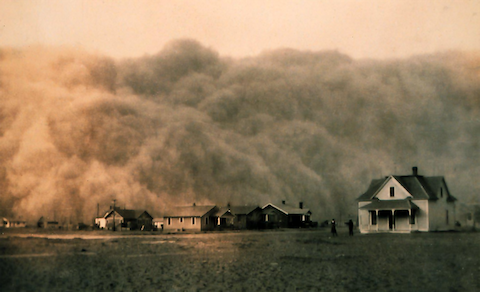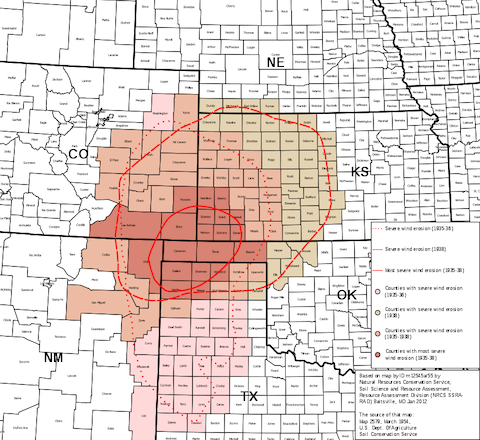
The greatest environmental disaster in American history lasted for eight years and displaced more than 3 million people. What was it?
The Dust Bowl—which refers both to this event and the place where it happened: some 100 million acres in Kansas, Colorado, Oklahoma, New Mexico, and Texas.
This area normally sees just 20 inches of rain a year. High winds from the Rocky Mountains roll across it. Summers bring scorching heat; winters bring Arctic blasts from Canada.
Explorers called it the Great American Desert and avoided it.
But in the late 1800s, agents from the government, eager to push development westward, rebranded it “the Great Plains.”
Anyone with an $18 filing fee could stake a homestead. People came in droves and found an ocean of native grasses.
These grasses had developed to withstand the prairie’s harsh conditions. Over thousands of years, they created the topsoil, held it in place against the wind, and trapped moisture to withstand periodic droughts.
But to the inexperienced farmers, it just looked like grass. They burned it or plowed it under, and planted wheat and other crops.
Grain production soared and the expansion seemed a success. Over the next 50 years, millions more settlers arrived.
Then, in 1929, the Great Depression hit. Grain prices collapsed. Worse, in 1931, the rains stopped.
What followed was a disaster of epic proportions, which we’ll cover in our next installment on the Dust Bowl.
Background
Synopsis: The Dust Bowl of the 1930’s was America’s greatest and most prolonged natural disaster. Extended drought coupled with ineffective land management practices and economic depression displaced millions of people from the Great Plains.

- “Dust Bowl” refers to both an era of American history and a region of the United States.
- The “Dust Bowl” era was marked by extended drought from 1931 to 1939 that spawned a series of major dust storms that stripped the fertile topsoil from the Great Plains. The drought caused crop failures that left millions of settlers destitute, starving, and homeless—from farmers to white-collar workers.
- The most severely impacted region during the Dust Bowl stretched from the High Plains of eastern Colorado, across western and central Kansas and the Oklahoma panhandle, to south to the Llano Estacado of northeastern New Mexico and northwestern Texas.
- Physical and anthropogenic causes compounded to create the perfect storm.
- The Dust Bowl region has a semiarid or steppe climate, which is characterized by less than 20 inches (50 cm) of rainfall per year on average and prone to recurrent periods of extended drought alternating with multiyear interludes of rain and floods.
- Early explorers avoided the region, calling it the “Great American Desert,” because the lack of surface water and timber made it less attractive than other areas for pioneer settlement and traditional agricultural practices. In the 1800s, land agents changed its name to the more appealing “Great Plains.”
- These flat prairies slope away from the Rocky Mountain foothills at a uniform rate of about 10 ft/mi (about 3 m/km). As air flows down the mountains, it warms and rushes eastward across the land, contributing to high winds.
- Long-term sea-surface temperature variations in the Atlantic and Pacific may influence the position of the jet stream, driving the cycle of episodic multiyear droughts.
- For millennia, the native shortgrass prairie biome thrived in the steppe climate, developing and protecting a rich soil profile and retaining moisture during droughts.
- Rapid settlement and overcultivation of the prairie by inexperienced farmers led to poor land management.
- In the 1860’s, as the Civil War ended and the Transcontinental Railroad was completed through the region, the federal government was eager to push development westward. Federal acts were signed providing homesteads to settlers for a filing fee as low as $18 and a promise to reside on and improve the land for a minimum of five years.
- Wet phases of the weather cycle led some politicians to postulate that “rain follows the plow”—that farming the land would bring a permanent increase in precipitation. This was not true, but each wet phase brought more settlement.
- Waves of migrants and immigrants arrived and began cultivating golden waves of grain across the prairie. Many of these settlers had never farmed before, and those who had a farming background came from the forgiving humid climates of the eastern U.S. and Europe.
- They brought with them a fundamental misunderstanding of how to farm the arid land, completely removing the native grasses that held the fine soil and moisture in place during drought and high winds. They used deep plowing and burned some fields to the ground to remove weeds and stubble, destroying nutrients in the unprotected soil. So, when droughts occurred, the soil became powdery.
- The economic vitality of the early 1900s shifted to a decade-long decline in the 1920’s that led to Great Depression.
- In the 1910’s, high wheat prices paid by the government during World War I and another wet cycle further stimulated settlement, doubling cultivated acreage in some regions.
- Around the same time, mechanized farming with emerging tractor technology lowered labor costs but required farmers to take out loans and mortgages to pay for the machinery.
- But in the late 1920’s, everything changed. Crop prices dropped as production outpaced demand, and massive infestations of rabbits and grasshoppers reduced crop yields. Desperate to make their mortgage payments, farmers cleared and planted even more acreage.
- Then, on Oct. 24, 1929, the Wall Street Crash began with “Black Thursday,” when the market lost 11% in one day. The market continued to decline through July 1932, losing 90% of its value compared to its previous high in September 1929. It took until 1954 for the market to finally recover to that level.
- Farmers produced a record volume of crops in 1931, but like everything else, crop prices had crashed and demand had dropped dramatically.
- And then, in the middle of this economic fiasco, the rain stopped in late 1931.
- Our story continues in Dust Bowl 2: Disaster Strikes.

